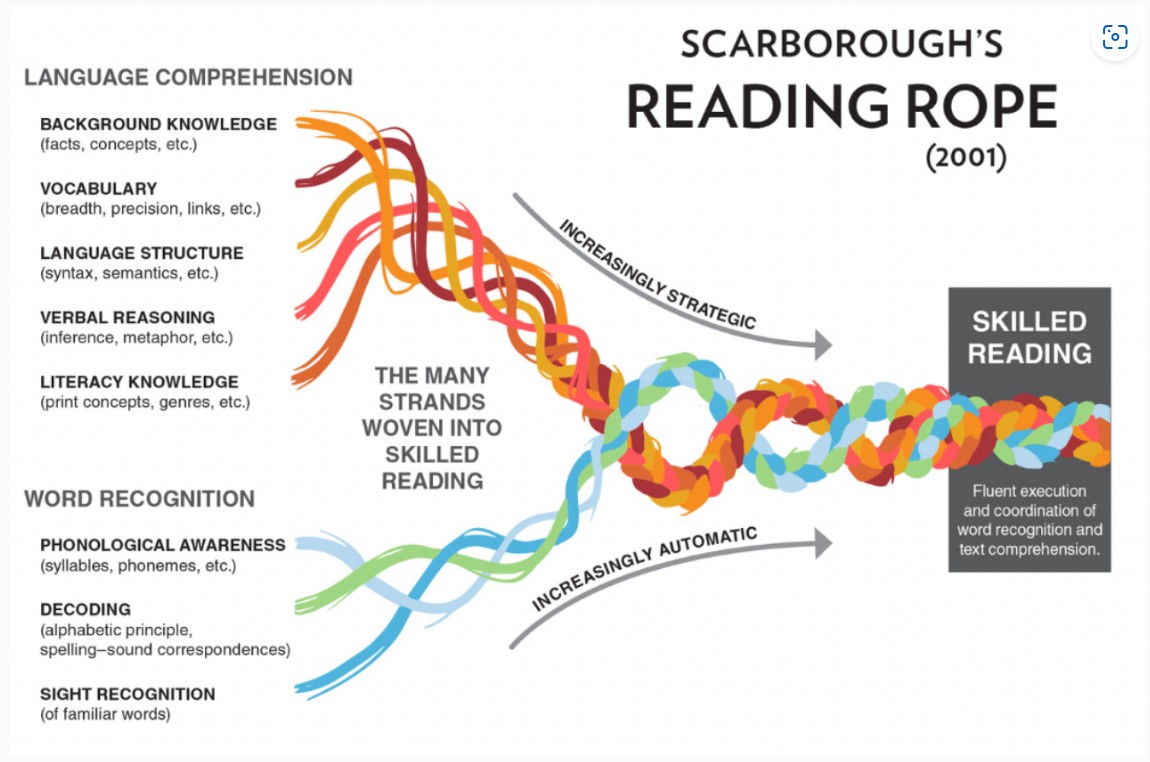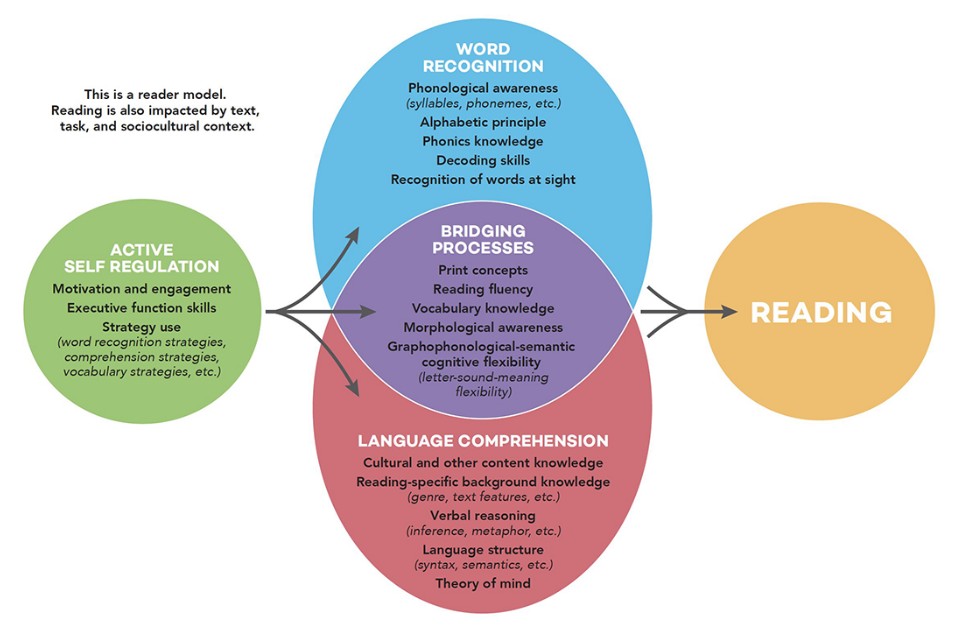What is the Science of Reading?

What is the Science of Reading?
Welcome, new grads, seasoned teachers, and every dedicated educator in between! I invite you to step with me into the compelling world of the science of reading, a research-based, time-tested approach that holds the golden key to what children need to become literate.
Science of learning promises to do this by bridging the gap between reading research and current classroom literacy teaching practices. The science of reading journey, and it is a true expedition, promises you an enriching voyage of understanding and a range of literacy-building strategies.
Let's start with the Simple view of Reading, first articulated by Philip Gough and William Tunmer in 1986. This model paints reading as a function of two key capabilities: decoding and language comprehension. Its 'simple' message is this: for reading comprehension to be strong, both decoding and language comprehension must also be strong. If one component is weak or absent, reading comprehension will also be weak or even entirely absent.

Decoding ability is a key to ultimate literacy success and is one part of the equation in the simple view of reading.
Decoding skills builds the ability for students to understand the connection between written and spoken language forms. In other words, we teach kids that reading is based on the alphabetic principles, to make the sound-letter link, and for our students to understand that speech sounds are represented by graphemes or letters.
Language comprehension, refers to the understanding of language in both oral and written forms. It links to vocabulary, syntax, and background knowledge, allowing children to make sense of what they read. Additionally, it serves as an essential blueprint or foundation for successful reading comprehension.
What is the Science of Reading? Scarborough's Rope
let us now unravel "Scarborough's Rope," coined by Hollis Scarborough in 2001. This is a now well known visual metaphor of a coiled rope symbolizing decoding and oral comprehension skills that ultimately bind together to represent reading mastery. This model intertwines two essential strands: language comprehension and word recognition. Both strands, woven together, form a sturdy rope, embodying fluent, skilled reading, an ideal destination for our students.

A proactive understanding of orthographic mapping, the ability to connect sounds to letters and words, allows students to confidently decode words- an integral part of Scarborough's rope.
In the realm of reading and language comprehension, linguistic factors such as vocabulary, syntax, and semantics play a substantial role in developing literacy skills. They serve as synergistic elements, working in tandem to enrich a student's comprehension of both written and spoken language.
Phonemic awareness is a fundamental element in the teaching of literacy skills and the science of reading. An early understanding of speech sounds and their direct correspondence to written symbols in the form of graphemes boosts students' reading speed and fluency, helping to foster student engagement and productive reading processes.
What is the Science of Reading?
The Active View of Reading
Now, onto the Active view of Reading by Nell Duke and Kelly Cartwright. This more recent reading model extends our understanding of reading processes and emphasizes reader’s active engagement in creating meaning from text. In some ways reading comprehension is like a puzzle-solving task, inspiring students to activate their existing knowledge, ask questions, anticipate new text, and constantly adjust their understanding of new material as they read.

Phonics is another cornerstone in understanding the science of reading. Explicit, systematic phonics instruction aids students to build letter-sound connections, decode, and spell words, which showcases its vital importance in mastering the alphabetic codes and to develop proficient reading and writing skills.
Reading fluency, an essential component in the science of reading, is characterized by speed, accuracy, and proper expression. By fostering reading fluency and helping our students to build these skills, we help kids to efficiently navigate texts, enhance their comprehension of text and overall build reading mastery.
Oral language comprehension also intersects meaningfully with reading comprehension, forming an inseparable pair in the science of reading. By strengthening oral language comprehension, we pave the way, and build a well constructed path to ensure our students' success in comprehension, accurate interpretation, and engagement with a diverse range of texts.
Understanding the science of reading and what it offers to educators also has direct implications for written language or written expression. These integral literacy skills often mirror successful reading development, and highlights the need for structured, sequential and evidence-based teaching methods.
The science of reading doesn't merely focus on individual components - it aims for the ultimate goal that all early year's educators strive for: reading mastery for all our students. This almost utopian wish is signalled by seamless, meaningful exploration of text, and by nurturing lifelong learners who grow to regard reading as not just a means of active learning but a source of enjoyment and relaxation.
What is the Science of Reading? Systematic Phonics Instruction
Best practices in teaching, as outlined by science of reading publications in both books form and journal articles, propose clear, direct, and systematic instruction in phonics and other major components. Such practices empower every student, regardless of each individual's starting point on their personal learning journey, to progress towards reading mastery.
Decoding, a fundamental aspect of all the previously discussed reading models, grants students the ability to ultimately transform written words into spoken language. Rooted deeply in phonics and phonemic awareness, decoding forms a major pillar in the construction of the science of reading temple.
Students having a rich vocabulary is paramount to reading comprehension success as it significantly contributes to comprehension of text. Vocabulary instruction is worthy as a seaparate topic of discussion and should be considered more than just students' recognising a list of tier 2 words; word recognition must entail understanding what words meanand how they relate to other words, their use in context, and connection to previously known words and understood concepts.
The science of reading advocates for striking a balance between students engaging with slightly challenging text and engagement with text that at forst glance might be considered incomprehensible. Lengthy, complex texts should never be viewed as de-motiving to confident learners but instead, should inspire students to apply their reading strategies to unveil hidden meanings that may well beyond surface level understanding.
What is the Science of Reading? Summary
The instructional practices suggested by the science of reading can be transformative in line with orthographic mapping principles. Such practices are designed to build in students' fundamental and core skills, gradually scaffold new and complex material, while building skills that are designed to finally lead to reading fluency mastery, thereby ensuring that no learner feels left behind.
The science of reading provides a compelling roadmap, guiding us towards creating literate, confident, and engaged learners. It favors an evidence-based, methodical approach to teaching reading, best represented by a structured synthetic phonics approach that uses speech to print methods of instruction supported by decodable readers, and reinforces our mission as educators: to make every child a successful reader.
REFERENCES:
Jump, J & Kopp, K. (2023) What the Science of Reading says about Reading Comprehension and Content Knowledge, Shell Educational Publishing inc
Uploaded 10/2023
